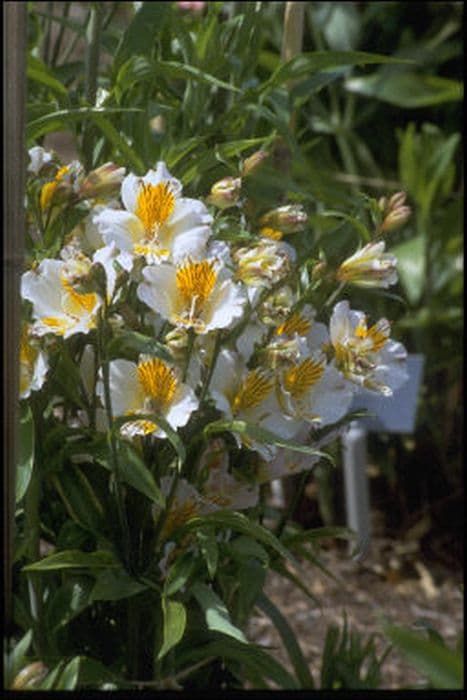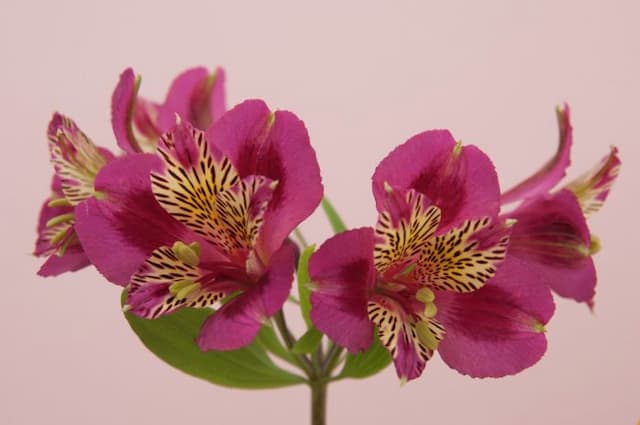Peruvian Lily Alstroemeria Princess Mathilde = 'Zaprimat' (PBR) (Princess Series)
![Peruvian lily [Princess Mathilde]](/_next/image?url=https%3A%2F%2Fplants-admin.emdemapps.com%2Fimages%2Fplants%2F%2Fimages%2F604b5f9659c77.png&w=3840&q=75)
ABOUT
Alstroemeria Princess Mathilde, part of the Princess Series, is a captivating perennial that boasts an attractive appearance. This plant is known for its beautiful blooms which come in a stunning color palette. The flowers feature a combination of soft peach and creamy yellow hues, creating a warm and inviting look. Each blossom has delicate, slightly ruffled edges which adds to their charm and elegance. The petals exhibit intricate speckling and streaks in a contrasting darker tone, typically a brownish or maroon color, which draw the eye and enhance their ornamental appeal. The foliage of the Alstroemeria Princess Mathilde is also noteworthy. The leaves are lance-shaped with a deep green color that serves as a lush backdrop to the striking flowers. The arrangement of the leaves is symmetrical and neat, providing a strong sense of order and structure to the plant's overall appearance. This Alstroemeria creates a bushy clump of foliage that remains attractive even when the plant is not in bloom. With its striking colors and patterns, Alstroemeria Princess Mathilde is a popular choice for adding a touch of elegance to gardens and floral arrangements. The blooms are not only eye-catching but are also known to be long-lasting, which makes them ideal for cut flower displays. The overall appearance of Alstroemeria Princess Mathilde is one of vibrant beauty and charm, perfect for enhancing any setting in which it is placed.
About this plant
 Names
NamesFamily
Alstroemeriaceae
Synonyms
Inca Lily, Peruvian Lily, Lily of the Incas
Common names
Alstroemeria 'Zaprimat'
 Toxicity
ToxicityTo humans
The Alstroemeria, commonly known as Peruvian Lily or Lily of the Incas, has a low level of toxicity to humans. Skin contact with the sap can cause dermatitis or skin irritation in some sensitive individuals. If ingested, it may result in mild gastrointestinal upset, such as nausea or vomiting. It is advisable to handle these plants with care and avoid ingestion to prevent any discomfort.
To pets
The Alstroemeria, commonly known as Peruvian Lily or Lily of the Incas, can be toxic to pets if ingested. While it is not considered highly toxic, consumption of any part of the plant can cause mild gastrointestinal symptoms such as vomiting or diarrhea in pets like cats and dogs. It is recommended to keep these plants out of reach of pets to prevent any potential health issues.
 Characteristics
CharacteristicsLife cycle
Perennials
Foliage type
Deciduous
Color of leaves
Green
Flower color
Mixed
Height
1-2 feet (30-60 cm)
Spread
1-2 feet (30-60 cm)
Plant type
Bulb
Hardiness zones
7
Native area
South America
Benefits
 General Benefits
General Benefits- Long blooming period: The Alstroemeria, also known as the Peruvian Lily or Lily of the Incas, frequently blooms from late spring to early fall, providing vibrant color over a long period.
- Attractive to pollinators: Peruvian Lilies attract bees, butterflies, and birds, therefore supporting local ecosystems and pollinator populations.
- Great cut flowers: These flowers have excellent vase life, making them ideal for fresh floral arrangements in homes and events.
- Low maintenance: Peruvian Lilies are relatively easy to care for, requiring only basic gardening knowledge and minimal upkeep.
- Drought tolerance: Once established, they have a degree of drought resistance, making them suitable for xeriscaping and reducing the need for frequent watering.
- Wide color range: They come in a variety of colors, which provides flexibility in garden design and the ability to create diverse color schemes.
- Cold hardiness: Capable of withstanding cooler temperatures, they are suitable for a range of climates and can be grown in many temperate regions.
 Medical Properties
Medical PropertiesThis plant is not used for medical purposes.
 Air-purifying Qualities
Air-purifying QualitiesThis plant is not specifically known for air purifying qualities.
 Other Uses
Other Uses- Alstroemerias, often referred to as Peruvian lilies or lily of the Incas, can be used as natural dyes for fabrics and art projects due to their brightly colored petals.
- When dried and pressed, Peruvian lilies add an exotic touch to homemade paper or can be used to create botanical bookmarks and cards.
- The petals of Peruvian lilies can be used in culinary presentation to decorate cakes and desserts, or frozen into ice cubes for a splash of color in drinks.
- These flowers are often utilized in photography projects and art classes to teach concepts of color, composition, and natural form.
- Peruvian lilies can be incorporated into potpourri mixes, sometimes dried with a fixative to prolong their sweet, fresh scent.
- These flowers can be a natural pest deterrent in gardens when their scent or sap is unappealing to certain insects.
- As symbols of devotion and friendship, Peruvian lilies are used in cultural ceremonies and events beyond their decorative appeal.
- The rigid stems of Peruvian lilies can be used creatively for supporting or adding structure to delicate or climbing plants in the garden.
- Due to their durability, Peruvian lilies can be featured in educational settings to teach botany and horticulture without wilting too quickly.
- Peruvian lilies can be used in artistic floral arrangements not only for their beauty but also to represent complex concepts, like resilience or prosperity, in art therapy.
Interesting Facts
 Feng Shui
Feng ShuiThe Peruvian Lily is not used in Feng Shui practice.
 Zodiac Sign Compitability
Zodiac Sign CompitabilityThe Peruvian Lily is not used in astrology practice.
 Plant Symbolism
Plant Symbolism- Friendship and Devotion: Alstroemerias, commonly known as Peruvian Lilies or Lily of the Incas, often symbolize strong bonds of friendship due to their twisting leaves, which represent the intertwining of relationships.
- Wealth, Prosperity, and Fortune: The Peruvian Lily is sometimes associated with wealth and prosperity, which is a common symbol due to its abundant flowers and long-lasting nature.
- Aspiring Success: The unique patterns on the petals can represent aspiring towards achievements, suitable for occasions that celebrate personal or professional milestones.
- Mutual Support: As the leaves of Peruvian Lilies grow upside down, with the twist symbolizing the mutual support among friends, the flower is often given to convey the message of support and the strength gained from such relationships.
 Water
WaterPeruvian lilies, which Alstroemeria Princess Mathilde belongs to, prefer consistent moisture and should be watered once the top inch of soil begins to dry out. Generally, this could be approximately once a week, but the frequency may increase during hot, dry periods and decrease during cooler, rainy spells. A deep watering that provides about a half to one gallon per plant each time is beneficial, promoting deep root growth. Ensure that water penetrates the soil rather than just wetting the surface, but avoid waterlogging the soil as this can lead to root rot.
 Light
LightPeruvian lilies thrive in bright, indirect sunlight or partial shade. They should be placed in a location where they receive morning sunlight and are protected from the intense afternoon sun. An east-facing garden spot is ideal, providing the gentle early sun and shielding the plant from scorching midday rays.
 Temperature
TemperaturePeruvian lilies prefer moderate temperatures and can tolerate a range from approximately 40 to 80 degrees Fahrenheit, with the ideal growing range being between 65 and 75 degrees Fahrenheit. They can withstand a light frost, but it is imperative to protect them from prolonged exposure to freezing temperatures to ensure their survival.
 Pruning
PruningPeruvian lilies benefit from pruning to remove spent flowers and encourage continuous blooming throughout the season. Cut back flower stems after the blooms fade to promote new growth. Pruning is also necessary to tidy up any dead leaves or stems, typically in late winter or early spring before new growth begins.
 Cleaning
CleaningAs needed
 Soil
SoilPrincess Lily 'Mathilde' thrives in fertile, well-drained soil with a pH between 6.5 and 7.0. A mix of loamy garden soil, peat, coarse sand, and a slow-release fertilizer is ideal for maintaining nutrient-rich and well-aerated conditions conducive to its growth.
 Repotting
RepottingPrincess Lily 'Mathilde' should be repotted every 2 to 3 years, or when it becomes root-bound. The best time to repot is in the spring before the growing season begins.
 Humidity & Misting
Humidity & MistingPrincess Lily 'Mathilde' prefers moderate humidity levels, around 40-60%. Protect it from overly dry air, which may require occasional misting or a pebble tray to maintain the ideal humidity.
 Suitable locations
Suitable locationsIndoor
Place in bright, indirect light, ensure good drainage.
Outdoor
Full sun to partial shade, well-drained soil, mulch well.
Hardiness zone
7-10 USDA
 Life cycle
Life cycleAlstroemeria Princess Mathilde typically begins its life cycle when the rhizomes are planted in well-draining soil during spring. After planting, the shoots emerge from the rhizomes and grow into mature plants with characteristic lance-shaped leaves. As the plant matures, it develops sturdy stems that give way to the signature trumpet-shaped flowers, which come in a variety of colors, blooming primarily in summer but can extend into fall. Once flowering is completed, the plant sets seed, although propagation by seed is less common compared to vegetative multiplication through division of the rhizomes. During the winter or in response to stressful conditions, the above-ground foliage dies back, with the rhizomes remaining dormant underground until the next growing season when the cycle repeats. Over time, the clumps of rhizomes can become crowded, necessitating division every few years to maintain plant vigor and flower production.
 Propogation
PropogationPropogation time
Spring-Early Summer
The most popular method of propagation for the Alstroemeria Princess Mathilde is division. This process involves carefully separating the rhizomes of a mature plant, ensuring that each divided piece has at least one or two growth points or eye buds. Division is typically done in the spring or early summer after the danger of frost has passed and the plant has started to grow. Gardeners dig up the Alstroemeria clump and gently tease apart the rhizomes, cutting through them if necessary with a sharp knife. The separated sections are then immediately planted in well-draining soil at a depth approximately the same as they were growing previously. This allows enough time for the new plants to become established before the onset of colder weather. Care must be taken to keep the new divisions well-watered and shaded from intense sunlight until they show signs of new growth.






![Peruvian lily [Inca Coral]](/_next/image?url=https%3A%2F%2Fplants-admin.emdemapps.com%2Fimages%2Fplants%2F%2Fimages%2F604b5b79b85ce.png&w=640&q=75)
![Peruvian lily [Inca Exotica]](/_next/image?url=https%3A%2F%2Fplants-admin.emdemapps.com%2Fimages%2Fplants%2F%2Fimages%2F604b5ec0e34a9.png&w=640&q=75)
![Peruvian lily [Inca Milk]](/_next/image?url=https%3A%2F%2Fplants-admin.emdemapps.com%2Fimages%2Fplants%2F%2Fimages%2F604b5f14b0b6a.png&w=640&q=75)
![Peruvian lily [Inticancha Dark Purple]](/_next/image?url=https%3A%2F%2Fplants-admin.emdemapps.com%2Fimages%2Fplants%2F%2Fimages%2F604b5381bb78f.png&w=640&q=75)